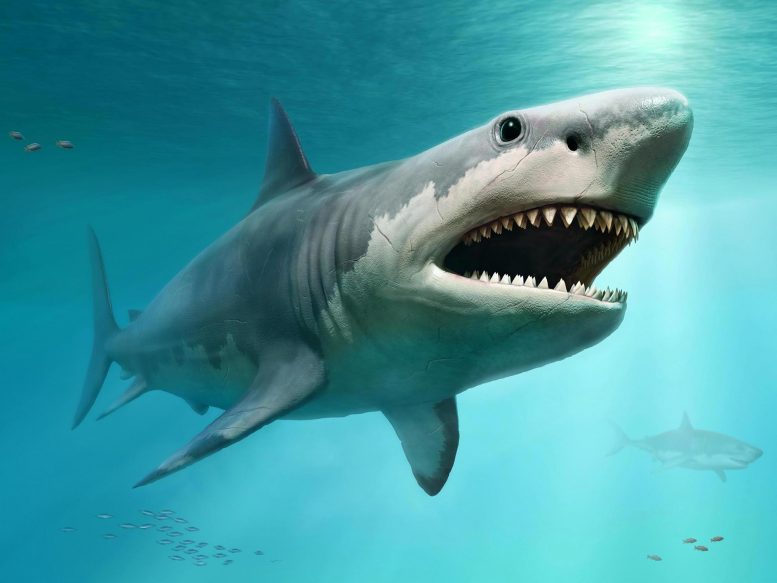
Artist’s illustration of the Megalodon. However, new scientific research shows that no one knows what the Megalodon really looked like.
Latest study reveals no one still knows what the Megalodon really looked like. DePaul University shark researchers say the mystery makes paleontology an exciting scientific field.
A new scientific study shows that all previously proposed body forms of the gigantic Megalodon, or megatooth shark, which lived nearly worldwide roughly 15-3.6 million years ago, remain in the realm of speculations.
“The study may appear to be a step backward in science, but the continued mystery makes paleontology, the study of prehistoric life, a fascinating and exciting scientific field,” said Kenshu Shimada, DePaul University paleobiology professor and a coauthor of the study. This latest research shedding light on the reality about the current understanding of the body shape of the Megalodon (formally called Otodus megalodon) appears in the international journal Historical Biology.
Otodus megalodon is typically portrayed as a super-sized, monstrous shark in novels and films such as the 2018 sci-fi film “The Meg.” Previous studies suggest that the shark likely reached lengths of at least 50 feet (15 meters) and possibly as much as 65 feet (20 meters).
“This new study shows that there are currently no scientific means to support or refute the accuracy of any of the previously published body forms of O. megalodon,” noted lead author Phillip Sternes, who graduated from DePaul in 2019 and is currently a Ph.D. candidate at the University of California, Riverside. Shimada mentored Sternes in his DePaul lab in Chicago, and the new study additionally includes Shimada’s current graduate student, Jake Wood, as coauthor.
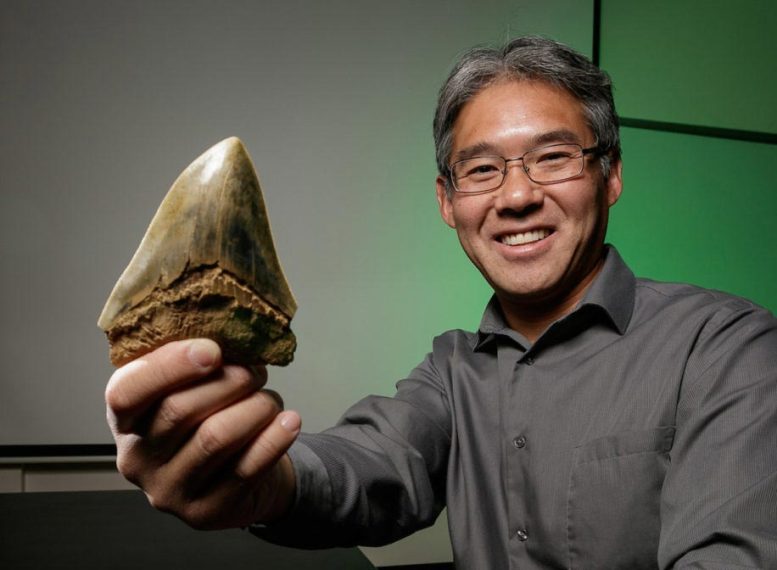
Paleobiologist Kenshu Shimada (DePaul University, Chicago) holds a tooth of an extinct shark Otodus megalodon, or the so-called “Meg” or megatooth shark. (DePaul University/Jeff Carrion). Credit: DePaul University/Jeff Carrion
Otodus megalodon is known only from its teeth and vertebrae in the fossil record, and traditionally the modern great white shark (Carcharodon carcharias) was used as a model for the body form of O. megalodon. Carcharodon carcharias belongs to the shark family Lamnidae, or lamnids, also including the mako, porbeagle, and salmon sharks, and they are regionally endothermic (partially warm-blooded), allowing them to be active predators. Otodus megalodon is not a lamnid shark, but it was previously inferred to also have been regionally endothermic. Based on the inference, yet another previous study used two-dimensional geometric shape analyses on the body forms of modern lamnids to propose an inferred body form of O. megalodon.
The new study by Sternes, Wood and Shimada examined whether such a two-dimensional approach can actually differentiate the body forms represented by modern endothermic (warm-blooded) species from those of modern ectothermic (cold-blooded) ones within the shark order called Lamniformes, which also includes Otodus megalodon. The study strongly indicates that, two-dimensionally, there is no relationship between thermophysiology and body form in lamniforms. “Although it is still possible that O. megalodon could have resembled the modern great white shark or lamnids, our results suggest that the two-dimensional approach does not necessarily decisively allow the body form reconstruction for O. megalodon,” Wood said.
“All previously proposed body forms of Otodus megalodon should be regarded as speculations from the scientific standpoint,” Sternes said. “Any meaningful discussion about the body form of O. megalodon would require the discovery of at least one complete, or nearly complete, skeleton of the species in the fossil record,” added Wood. “The fact that we still don’t know exactly how O. megalodon looked keeps our imagination going,” Shimada said. “This is exactly why the science of paleontology continues to be an exciting academic field. We’ll continue looking for more clues in the fossil record.”
Reference: “Body forms of extant lamniform sharks (Elasmobranchii: Lamniformes), and comments on the morphology of the extinct megatooth shark, Otodus megalodon, and the evolution of lamniform thermophysiology” by Phillip C. Sternes, Jake J. Wood and Kenshu Shimada, 6 February 2022, Historical Biology.
DOI: 10.1080/08912963.2021.2025228

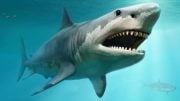
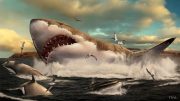
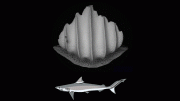
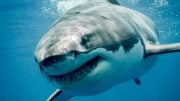


Very Interesting.
Ask any Dentist and he will swear that Dental Records are Unique and can be used to recreate the murdered human victims body structure and other deatils like muscle, flesh etc.can be filled in by extrapolation by using wel established methodologies to recreate what the dead victim looked like. Using Current Data of Known Characteristics of the Victim or even persons who have passed away because of natural causes, the accuracy of these predictions can be improved. Baseline for two legged primates!
This appears to be a Data Science Problem in the Field of Palnetology for Sea Creatures. In this case we have a Huge Shark Tooth and want to extrapolate the same to create a possible set of pictures for what the owner of the Huge Shark Tooth may have looked like 3 to 15 million years ago.
Some thoughts way out in left field for consideration.
1. Growth Harmones in Sea Creatures.
2. Tales of Whales of Large Size (Mammalian Warm Blooded abound. 1. Moby Dick. 2. A huge Whale which protected the Human Race by swallowing it whole, in which Humans resided till the water planet, became a Single Continent surrounded by Water and we emerged from the whales belly and became land lubbers! Then the Continents Split into Many Land areas based on plate tectonics .
3. There are ofcourse cold blodded creatures and waarm blooded creatures. That a species with Warm-Cold Blood or Cold-Warm blood could have existed is interesting. We have species of all types of Sea Creatures existing today , which have probably emerged from these ancient varities of Sea Creatures. There shapes are known. They exist in all shapes and sizes.
4. Building a detailed data base of all such existing ,sea creatures which exist along with species characteristics like blood type (Warm -Cold Range), dimensions (Small – Medium-Large), growth harmones, the Suns impact on Growth of such creatures under various conditions etc. can improve the accuracy of the predicted possible shapes of the Mastadon! In historical times Gaints appear to have existed of many different Species. Why not Sea Creatures?
Views expressed are personal and not binding on anyone!
You certainly have a vivid imagination. I commend you on not letting facts get in the way of your conjectures. Your writing reminds me of a quote from Mark Twain:
“There is something fascinating about science. One gets such wholesale returns of conjecture out of such a trifling investment of fact.”
Who knows, maybe it had proportions similar to angler fish…just 4 meters long with a massive jaw. A comical thought but not impossible to contemplate.